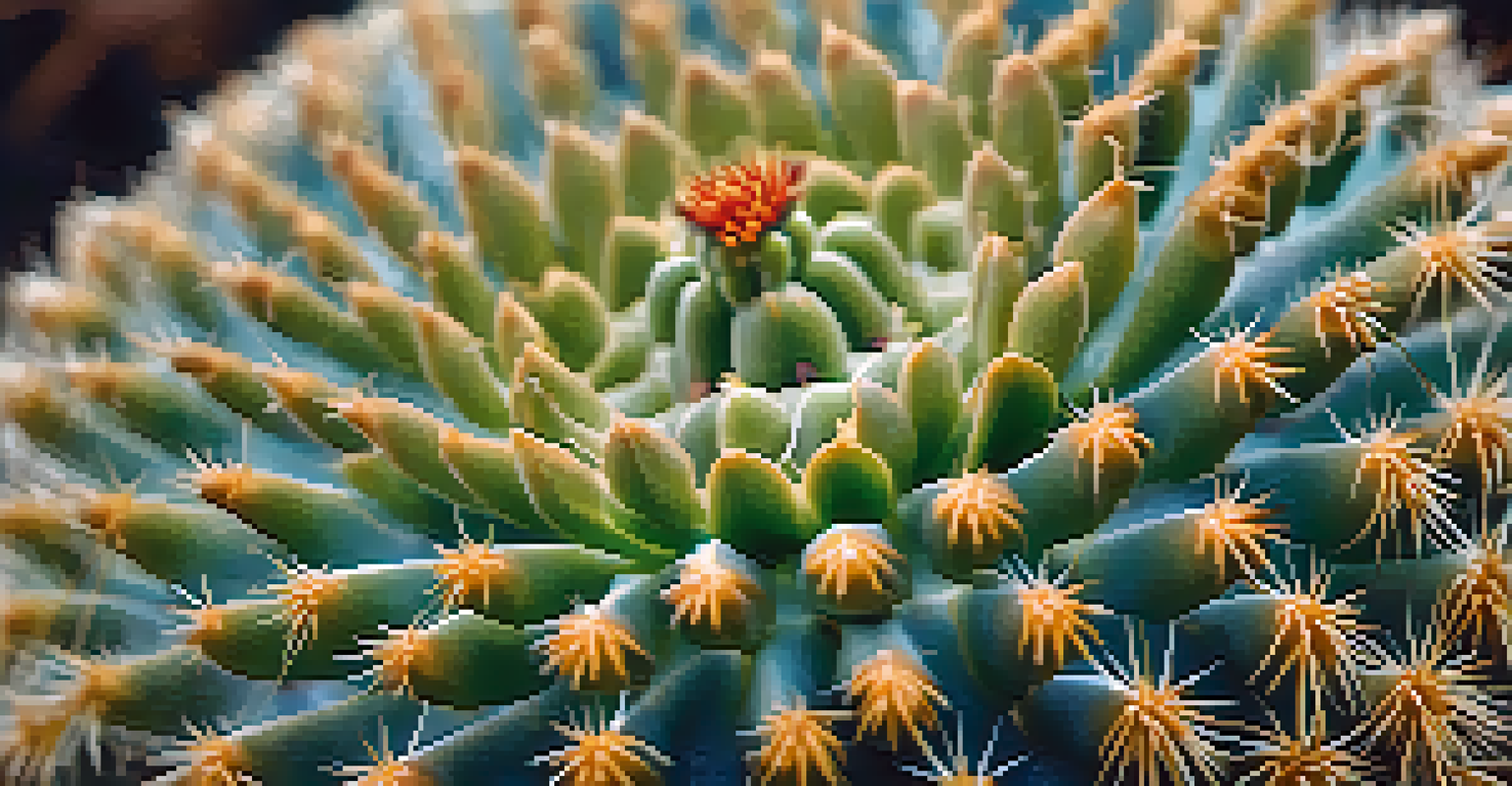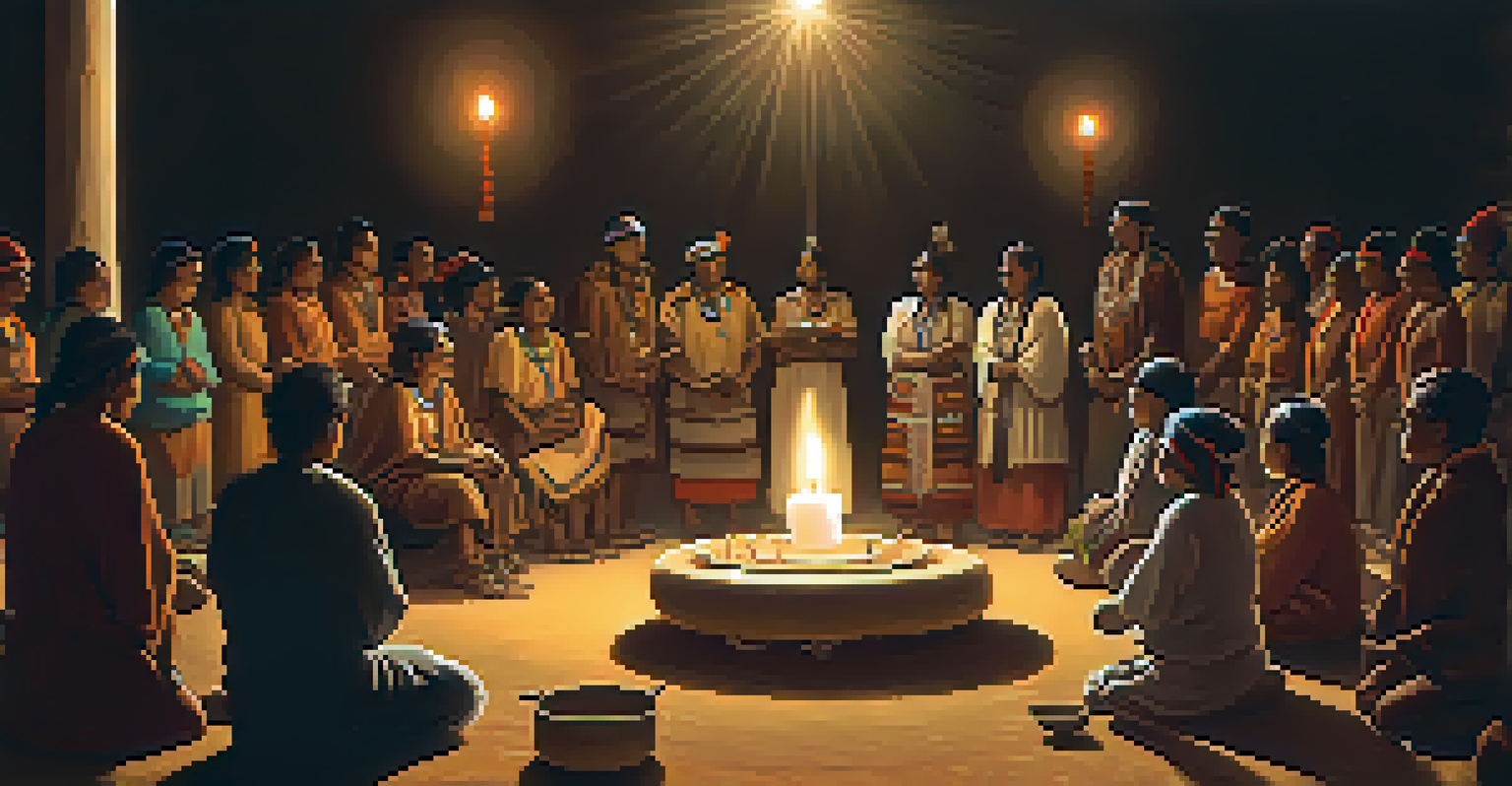Historical Use of Peyote in Indigenous Vision Quest Practices

Understanding Peyote and Its Cultural Significance
Peyote, a small cactus native to Mexico and the southwestern United States, holds deep spiritual significance for many Indigenous cultures. Traditionally, it's known for its psychoactive properties, primarily due to the compound mescaline. This cactus has been used for centuries, not just as a ritual substance, but as a source of healing and guidance.
Peyote is a sacred medicine that opens the door to the spiritual world and brings healing to the heart and mind.
For Indigenous peoples, peyote is more than just a plant; it's a sacred tool for connecting with the spiritual world. Its use in ceremonial contexts underscores its importance in maintaining cultural identity and practices. Many tribes, such as the Native American Church, incorporate peyote into their spiritual rituals, emphasizing its role as a bridge to the divine.
The reverence for peyote is reflected in various stories and teachings passed down through generations. These narratives often highlight the plant's ability to foster self-discovery, healing, and communal bonding, making it a cornerstone of Indigenous spirituality.
Vision Quests: A Journey of Spiritual Awakening
Vision quests are transformative experiences where individuals seek personal insight, often involving solitude, fasting, and sometimes the use of sacred plants like peyote. This practice is common among various Indigenous tribes and is seen as a rite of passage or a means of spiritual growth. The quest is not just a physical journey but also an emotional and spiritual exploration.

During a vision quest, participants often retreat to a secluded area, disconnecting from everyday life to seek clarity and guidance. The use of peyote can enhance this experience, helping individuals access deeper states of consciousness. This connection to the spiritual realm can provide profound insights or visions that guide their life choices.
Peyote's Spiritual Significance
Peyote is a sacred cactus used by Indigenous cultures for spiritual connection, healing, and cultural identity.
The results of a vision quest can vary greatly, with some individuals emerging with a clear sense of purpose, while others may receive a more ambiguous message. Regardless of the outcome, these quests are deeply respected and viewed as essential for personal development within Indigenous cultures.
Historical Context of Peyote Use in Indigenous Practices
The use of peyote dates back thousands of years, with archaeological evidence suggesting its consumption in ritual contexts among Indigenous peoples in Mesoamerica. These early uses highlight the cactus's integral role in spiritual and communal practices long before European contact. Peyote was often associated with rites aimed at healing and divination.
The use of peyote is a communal activity that fosters a sense of belonging and healing among participants.
With the arrival of European settlers, Indigenous traditions faced significant challenges, yet the use of peyote persisted. Many tribes adapted their practices, incorporating peyote into newly formed religious structures that emphasized resilience and cultural continuity. This adaptability showcases the enduring significance of peyote despite external pressures.
As peyote became more widely recognized, particularly in the 19th and 20th centuries, it was often misunderstood or stigmatized. However, Indigenous groups defended their right to use peyote as a sacred element of their spiritual heritage, leading to legal battles and the establishment of the Native American Church, which formalized its use in a religious context.
The Role of Peyote in Healing Practices
In many Indigenous cultures, peyote is viewed as a powerful healing agent, both physically and spiritually. Its consumption is often part of ceremonies aimed at addressing personal or communal issues, such as illness, grief, or conflict. The belief is that peyote can reveal the root causes of these challenges, allowing for a more profound healing process.
Traditional healers, or medicine people, often guide individuals through peyote ceremonies, ensuring that the experience is respectful and meaningful. These ceremonies can involve singing, drumming, and communal support, creating a safe space for participants to explore their inner selves. The collective nature of these gatherings emphasizes the importance of community in the healing journey.
Challenges to Peyote's Future
Peyote faces threats from habitat loss and legal restrictions, prompting Indigenous groups to advocate for its protection and cultural rights.
The healing properties of peyote are not solely attributed to its psychoactive effects but also to the ritualistic aspects of its use. By engaging in ceremonies, individuals often find a sense of belonging and support, which can be as important as the peyote itself in fostering mental and emotional well-being.
Modern Perspectives on Peyote Use
In recent years, there has been a resurgence of interest in peyote, both within Indigenous communities and among those seeking alternative spiritual experiences. This renewed focus has sparked conversations about cultural appropriation and the need for respectful engagement with Indigenous practices. It's crucial to understand the historical and cultural contexts of peyote use to appreciate its significance fully.
Many Indigenous leaders advocate for the protection of peyote habitats, as overharvesting and environmental changes threaten its availability. Efforts are being made to ensure that peyote is used sustainably and that its cultural significance is preserved for future generations. This advocacy highlights the need for a balance between cultural respect and modern exploration.
As more people seek to experience peyote's effects, the importance of education and respect cannot be overstated. Engaging with Indigenous communities and learning about their practices fosters a deeper understanding of peyote's role in their culture, ensuring that experiences are meaningful and respectful.
Challenges Facing Peyote and Indigenous Practices
Despite its revered status, peyote faces numerous challenges today, including habitat loss and legal restrictions. As urbanization and climate change impact its natural growth areas, the sustainability of peyote becomes a pressing concern. Many Indigenous groups are actively working to protect these habitats and advocate for the rights to use peyote in their spiritual practices.
Legal issues surrounding peyote use continue to evolve, particularly as more people engage with Indigenous spiritual practices. While some legal protections exist for Native American Church members, the broader context remains complex. Advocacy for the rights of Indigenous peoples to use peyote as part of their traditions is ongoing, reflecting a struggle for cultural sovereignty.
Vision Quests and Personal Growth
Vision quests involving peyote serve as transformative experiences for individuals seeking spiritual insight and personal development.
These challenges highlight the delicate balance between preserving ancient traditions and adapting to modern realities. It is essential to listen to Indigenous voices in these discussions, ensuring that their rights and cultural practices are respected in the face of changing societal norms.
The Future of Peyote in Indigenous Cultures
Looking ahead, the future of peyote in Indigenous cultures depends on both preservation and adaptation. As younger generations engage with these traditions, there is an opportunity to blend ancient practices with contemporary understanding. This fusion can help ensure that peyote remains relevant and respected within spiritual frameworks.
Educational initiatives aimed at raising awareness about peyote's cultural significance are vital. By fostering understanding within broader society, there is potential for greater respect for Indigenous practices and the sustainable use of peyote. These efforts can help bridge gaps between Indigenous and non-Indigenous communities.

Ultimately, the future of peyote is intertwined with the resilience of Indigenous cultures. By honoring the historical and spiritual dimensions of peyote, we can support efforts to protect this sacred plant and the practices surrounding it, ensuring that it continues to inspire and guide future generations.